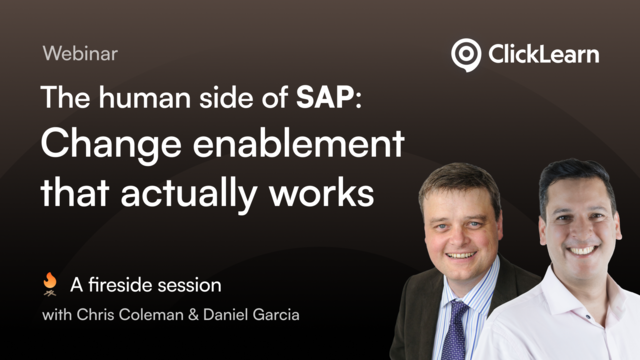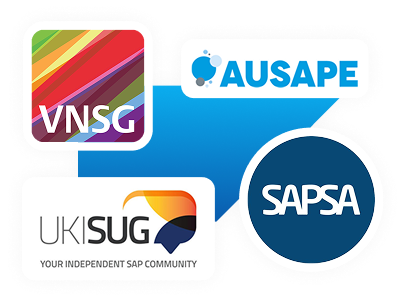Webinar
The human side of SAP: Change enablement that actually works

The biggest challenge in any SAP transformation? It’s not the system. It’s getting people to change how they work.
In this candid fireside session, SAP change management expert Chris Coleman and user adoption expert Daniel Garcia break down what it really takes to move employees from what they do today to what they need to do tomorrow – and how to help people navigate that change.
Spoiler: It’s not about marathon training sessions or dusty documentation.
It’s about creating small, frequent, learning in the flow of work that feel natural – not overwhelming.
Expect an honest conversation filled with practical insights, including:
👉 Why resistance isn’t the problem
👉 The “watering the plants” mindset that keeps change alive and do-able
👉 How to bake adoption into daily workflows
👉 Why great documentation isn’t created once – it evolves with your team
👉 Proven change enablement strategies you can put into action tomorrow
If you’re leading an SAP rollout, driving process change, or struggling with user adoption, this is for you.
Join us and bring the human side of SAP to life.
Save your seat now.





Why you shouldn't overlook the human side of SAP change enablement
For enterprise training managers and ERP change leads, SAP change enablement is often the hardest part of an implementation. The biggest challenge isn’t configuring software – it’s getting people to embrace new ways of working. In fact, while most organizations recognize change management’s importance, far fewer have formal programs to address it.
The result? Users resist or revert to old habits, and the expected business benefits of the SAP project are put at risk. This guide offers best-practice strategies to tackle the people side of change – from building stakeholder alignment and trust, to delivering SAP user adoption training at the right time and format, to leveraging champions and fostering a continuous learning culture that actually makes change stick.
Build stakeholder alignment and user trust early
People drive the success of any SAP transformation. That’s why it’s critical to align stakeholders and build trust from day one of the project – not as an afterthought. Early and active sponsorship by leaders, combined with broad stakeholder engagement, lays a foundation of trust that will carry your initiative through challenges. Conversely, if you delay addressing the “human factor,” you risk confusion and skepticism that can breed resistance. To set your SAP change up for success, focus on alignment and trust through proactive communication and involvement.
Engage executives and sponsors visibly
Secure strong leadership alignment at the outset. Help senior leaders understand they must model the new behaviors and consistently communicate the vision for change. When top management is actively involved and visibly supportive, it signals to all employees that the change is real and important. Start change management efforts early enough to craft a clear vision that resonates with both leadership and end users – this builds a foundation of trust long before training begins. Early engagement means that by the time go-live nears, users know what is changing and why, instead of feeling blindsided.
Communicate openly and listen to concerns
Trust is earned through transparency and empathy. Rather than simply announcing new processes, create two-way dialogue. Use surveys, town halls, and informal chats to hear what people are worried about.
Practice active listening – go out and talk with end users one-on-one or in small groups about their daily work and pain points. Acknowledge the challenges they voice and incorporate their feedback into your plans when possible. When stakeholders feel heard and see their input valued, it builds credibility. It also uncovers real-world issues early so you can address them (for example, discovering a workflow nuance or exception nobody mentioned until a user spoke up). By treating user feedback as a vital resource rather than a nuisance, you demonstrate respect and build user trust.
Align on the “why” and WIIFM
Ensure every stakeholder – from executives to front-line employees – understands why the change is happening and “what’s in it for me.” Frame the SAP project in terms of solving real business problems and making employees’ work easier or more efficient. If people see the change enabling a better future state for them, they are far more likely to get on board.
On the flip side, if end users feel a new system is being forced on them with no clear benefit, trust erodes quickly. Communicate early and often about the business value and vision behind the SAP transformation. Reinforce these messages through multiple channels (emails, workshops, team meetings) and tailor them to different audiences – for example, addressing specific department workflows. This consistency helps align everyone on common goals and sets a positive tone.
Building stakeholder alignment and trust isn’t a one-time task – it’s an ongoing effort throughout the project. But by starting early, communicating transparently, and making people feel heard, you create a supportive environment where employees are willing to follow you into the new SAP future rather than cling to the past.
Deliver SAP training at the right time and in the right format
Training is where “rubber meets road” for user adoption – but traditional marathon classroom sessions and static manuals often fall flat. To truly enable SAP users, deliver training when they need it and in a format that fits how they learn and work. This means moving away from one-size-fits-all training delivered only pre-go-live. Instead, adopt a just-in-time, blended learning approach that provides continuous support.
Provide timely, on-demand learning support
Adults learn best in context – when they can immediately apply new knowledge. Plan to offer training and support at the moment of need (for example, when a user is trying out a new SAP process) rather than weeks or months in advance. One effective strategy is to make core learning content available on-demand so users can self-serve at their own pace. This acts like an interactive job aid or “digital coach” that employees can refer back to repeatedly.
In a real project example, a team deployed online learning modules for SAP tasks and allowed users to work through them individually. When some users still struggled to complete a process, the project team paused and brought in expert trainers to provide a quick refresher and Q&A after go-live – right when those users hit a roadblock. This agile, just-in-time intervention gave the users the confidence boost they needed to continue, and they could then return to the e-learning for ongoing reference.
The key is to be flexible: deliver a baseline of training before and during go-live, but be ready to inject additional help post-go-live exactly when and where users need it. This approach treats training not as a single event, but as an ongoing resource.
Use multiple formats to cater to different learning styles
Different people absorb information in different ways, so variety in training formats is essential. Relying on only slide decks or lengthy manuals will leave much of your audience behind. Instead, provide a mix of formats so users can choose what works best for them:
Role-based written guides – Step-by-step process guides or checklists tailored to each role’s tasks (so users see instructions in the context of their job). These serve as quick reference material.
Short video demos – Screen recordings with voiceover demonstrating common SAP transactions or workflows. Videos let users visually follow along and re-watch as needed; this can be hugely helpful for complex steps.
Interactive simulations or sandboxes – Safe environments where users can practice executing transactions hands-on, with guided prompts. This builds muscle memory and confidence.
Live workshops or Q&A sessions – Instructor-led sessions (virtual or in-person) used strategically to supplement self-study. Rather than long lectures, use live time to address specific questions, edge cases, or advanced scenarios that learners struggled with in self-paced training.
By blending e-learning, videos, and in-person support, you accommodate all learning styles and reinforce knowledge through multiple channels. Notably, make training content accessible on-demand (via an LMS, intranet or digital adoption tool) so employees can refresh their memory at the moment of need. Someone who attended training a month ago might only recall a portion of it – but if they can quickly pull up a 3-minute how-to video or simulation while doing the task, they can get unstuck and back to work.
Offering training in a “little and often” fashion – small, digestible modules instead of one-off marathons – helps prevent overload and improves retention. As one expert put it, 10 people sitting through the same class will each walk away with different pieces of knowledge. But when you allow learners to control the pace and review material multiple times, they’re more likely to grasp the parts they missed and achieve mastery. In summary: deliver training in the flow of work. Timely, relevant, and varied learning experiences will drive far higher SAP user adoption than any single crash course ever could.
Use champions and cross-functional collaboration to drive SAP user adoption
Lasting SAP adoption is a team effort that extends beyond the project team. One of the best ways to turn a daunting organization-wide change into a manageable journey is to leverage change champions and foster collaboration across departments. These strategies create a support network that propagates change from within peer groups, rather than relying only on top-down directives.
Form a cross-functional change team
Don’t silo change management within IT or HR – build a multidisciplinary team that spans the organization. Include project sponsors and managers, IT experts, key business leaders, plus a group of respected end users or “power users” from various departments.
This diverse change team serves as the backbone of your enablement efforts, ensuring all perspectives are represented. Clear roles and responsibilities should be defined for each member to foster accountability and smooth collaboration across functions. When everyone – from finance to operations to customer service – has a seat at the table, it’s easier to align on decisions and address impacts holistically. A cross-functional approach also prevents the common misalignment between IT and business goals by having both sides work together on user adoption plans.
Empower change champions at all levels
Identify influential employees in different teams to act as change champions (also called “project ambassadors” or super users). These are people who embrace the new SAP system early, or at least have the credibility and enthusiasm to rally their peers. Involve these champions from the start in design and testing, so they become knowledgeable super-users. Then, enable them to mentor and support their colleagues during rollout.
For example, champions can lead by example in using the new processes, answer peer questions, and provide honest feedback to the project team about what’s working or not. Because they speak the business language and share the same daily realities as their teammates, champions can often connect with end users more effectively than outside trainers. A network of engaged champions across the organization creates a grassroots push for adoption, amplifying the change far beyond what the core project team could do alone. This peer-to-peer element builds trust – users have colleagues they can turn to who genuinely understand their job context.
Foster open feedback and peer support
Encourage an atmosphere of collaboration, where project team members and end users continuously share insights. Set up regular cross-functional check-ins or “change agent” meetings to surface issues and highlight wins. If one department discovers a workaround or has a success story, let them share it with others. Likewise, if employees raise concerns or resistance, address it openly.
Sometimes the most resistant users can become your greatest allies once their concerns are heard and resolved. As change expert Chris Coleman notes, initial skeptics often point out blind spots in processes – when you work with them to fix those issues, they see the improvement and may turn into passionate advocates of the new system. Leveraging these formerly resistant folks as new champions (almost like “reformed smokers” who now tout the benefits) can be a powerful boost to adoption.
The lesson is to view resistance not as a threat, but as useful feedback and an opportunity to win converts. When people see colleagues who were doubtful eventually get onboard and succeed, it sends a strong message across teams.
In sum, change enablement isn’t the responsibility of one person or department. Build a coalition of sponsors, experts, and champions to drive SAP user adoption collectively. Through cross-functional collaboration, knowledge-sharing, and empowered champions, you create an internal support system that propels the change forward even when the project team isn’t in the room. Users feel supported by peers as well as leadership, which makes them far more willing to adopt new tools and processes.
Create a culture of continuous learning during and after SAP projects
Successful SAP change enablement doesn’t end at go-live – that’s just the beginning of user adoption. To ensure lasting success, organizations must cultivate a continuous learning culture around the new system. In practice, this means treating change as an ongoing journey and providing structures to support users long-term. Think of it like tending a garden: you need to keep “watering the plants” through regular nourishment, reinforcement, and adjustments to truly embed new ways of working.
Provide ongoing support and resources
After go-live, users will still encounter questions, new use cases, or even software updates that change how things work. Plan for robust post-go-live support to help people through this transition. Set up help desks or “hypercare” support teams that can respond to user issues in real time.
Leverage your network of champions as first-line support within departments – often a quick chat with a peer can resolve a problem faster than formal tickets. Make sure knowledge bases, FAQs, and training portals are kept available and updated so employees can self-serve answers at any time. Continuous learning means users should always know where to find help or refreshers, even months after rollout.
Keep training content and documentation up to date
An SAP environment will evolve with new features, process tweaks, and lessons learned from user feedback. Treat your training materials and documentation as living documents that must be maintained over time, not static one-off deliverables. Establish a sustainable process for updating screenshots, SOPs, and job aids whenever there are system changes or when feedback reveals something is unclear.
For example, if multiple users struggle with a particular step, refine the guide or add an explanatory video to address that gap. Regular content maintenance ensures that users aren’t relying on outdated information. This practice reinforces trust as well – employees see that the organization is committed to keeping them informed and capable in the new system, not just dropping SAP on them and walking away. Remember – documentation and training needs to be maintained throughout time, it’s not static. By continuously adapting your learning content, you prevent knowledge decay and help new behaviors stick.
Reinforce, reward, and iterate
To cement a culture of continuous learning, make it positive and ongoing. Celebrate quick wins and adoption successes openly – for instance, acknowledge teams that achieved high SAP usage or individuals who found innovative ways to use new features. Recognizing these “small victories” keeps momentum up and shows that the organization values the effort employees put into learning.
You can also incorporate gamification or incentives for completing advanced training modules or achieving certain proficiency. At the same time, continuously monitor user adoption metrics and gather feedback (via surveys or meetings) on how things are going.
Use an agile mindset of continuous improvement: periodically review what’s working and what isn’t, then adjust your support approach accordingly. Perhaps users need a refresher on a process six months in, or maybe a certain department would benefit from an extra training session after an SAP upgrade – be ready to provide that. When employees see that the company is invested in their ongoing development and is responsive to their needs, they remain engaged and willing to learn. Over time, this creates an atmosphere where learning new tools is “business as usual” rather than a dreaded disruption.
By building these habits of continuous learning and support into your SAP enablement program, you ensure that user adoption grows stronger over time instead of fading out. The goal is to make adaptive learning part of the company culture. Users should feel comfortable seeking out knowledge and know that improvement is a constant, shared objective. With leadership and change champions modeling this mindset, and the right resources in place, the organization as a whole becomes resilient and agile – able to not only implement SAP successfully, but to keep optimizing and thriving with it in the long run.